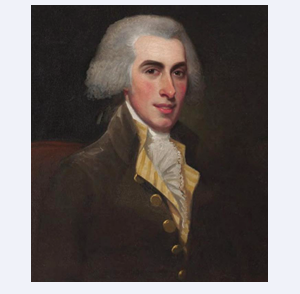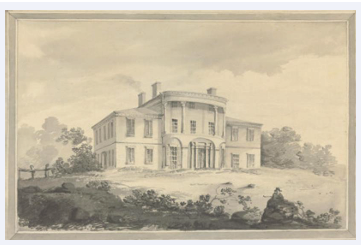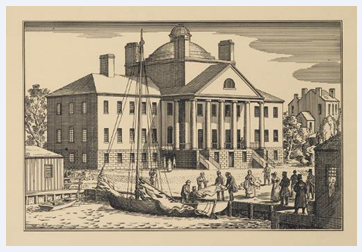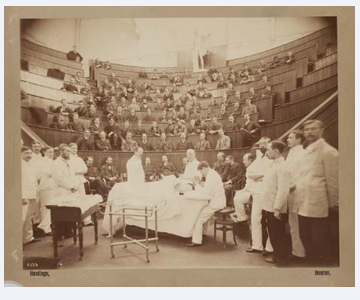Bulfinch and the Massachusetts General Hospital: History at the Intersection of Architecture and Medicine
- 1. Independent Scholar, India
- 2. Brigham and Women’s Hospital, USA
- 0. Massachusetts General Hospital, Boston, The Department of Anaesthesia, Harvard Medical School, Boston
Abstract
Albeit never trained in architectural design, Charles Bulfinch (1763-1844) is widely recollected as the first native-born American to practice architecture professionally. Inspired by continental influences, Bulfinch developed the neoclassicist style reflected in major private and public structures in Boston and Washington D.C. Although we have numerous studies of Bulfinch’s fascinating and pioneering architectural career, less is known about his intimate relationship to the medical field. Bulfinch was the chief designer of Massachusetts General Hospital, America’s third-oldest general hospital and Harvard Medical School’s first teaching hospital. Drawing on a wide range of underexplored primary and secondary sources, this article offers a historical recounting of Bulfinch’s life and architectural trajectory up to the conception and design of Massachusetts General Hospital. Then, it draws attention to the structure and organization of the Hospital, its position within the historical context of the time, and its lasting impact on the history of American medicine. In so doing, this article provides a fresh perspective into Boston’s healthcare architecture, the history of its preeminent hospital, and the legendary personality that made it what it is today.
Keywords
• Charles Bulfinch
• Boston
• Massachusetts General Hospital
• Hospital Architecture
• Ether Dome
CITATION
Shukl V, Desai SP. (2023) Bulfinch and the Massachusetts General Hospital: History at the Intersection of Architecture and Medicine. J Surg Transplant Sci 10(1): 1089.
INTRODUCTION
During his multidimensional career, Charles Bulfinch (1763 – 1844) (Figure 1)
Figure 1: Charles Bulfinch (1763-1844). Image by George W. Matthews (Public Domain).
engaged in local affairs that included public health, politics, town improvements, and architectural design. His memory remains alive through monumental buildings across New England and Washington D.C., among them Massachusetts General Hospital (MGH), and the U.S. Capitol. Harold Kirker and others have offered a comprehensive analysis of Bulfinch’s career [1-3], while numerous publications outline the history of MGH [4-6]. We recount Charles Bulfinch’s life as an architect, civil servant, and town planner, in particular his contribution to the construction of the operating theater in which the first public experiments with ether were performed in 1846.
EARLY LIFE
Charles’ father, Thomas Bulfinch (1728-1802), was a physician, and his mother, Susan Apthorp (1734-1815), came from a wealthy Boston family. His grandfather, Charles Apthorp (c. 1698-1758) donated a considerable sum to support the construction of King’s Chapel, the first Anglican Church in Boston [2]. This church’s ionic columns and classic lines made a lasting impression on young Charles, who began sketching private and public buildings at age ten. His grandfather’s architectural library afforded an early acquaintance with English Palladian architecture [7]. Little is known of Bulfinch’s boyhood, except that he studied at Boston Latin School until the outbreak of the American Revolutionary War (1775-83). He experienced the eleven-month siege of Boston (1775-1776) and watched the Battle of Bunker Hill (17 June 1775) from the roof of his family mansion [2]. Many public and private buildings were demolished in Boston, and the financial situation of many was deplorable. Bulfinch entered Harvard College in 1788 and graduated with a master’s degree in mathematics and perspective three years later. This education had little influence on his architectural career [2]. Exposure to historic events and the ravages of war likely inspired Bulfinch to play a significant role in the reconstruction of the new nation. He began work quite humbly in the counting room of Joseph Barrell (1739-1804), a prosperous merchant and a close friend of his father. He wrote in 1791, I was at leisure to cultivate a taste for Architecture, which was encouraged by attending to Mr. Barrell’s improvement of his estate and [the improvements] on our dwelling house and the houses of some friends, all of which had become exceedingly dilapidated during the war [8].
An inheritance from a rich English relative allowed Bulfinch to undertake an 18th-century gentleman’s Grand Tour of Europe from 1785 to 1787. Bulfinch travelled extensively following an itinerary provided by his mentor, Thomas Jefferson (c. 1743-1826), a wealthy Virginia statesman and architecture connoisseur. The journey revolved around classical architecture dominating many European cities. Bulfinch was profoundly impressed by these heritage structures, influenced by ancient Greek and Roman architectural principles [2].
The acquisition of architectural pattern books came to enrich his existing collection of relevant books and studies on the topic [8]. The detailed accounts of his trips speak to Bulfinch’s admiration of the grandeur of continental public structures and the excellent symmetry of streetscapes [9].
Early career as an architect and administrator
Bulfinch returned from the Grand Tour in 1787 and married a distant maternal cousin, Hannah Apthorp (1767-1851), and got involved in local politics [1]. Professionally, his first architectural project consisted of the design of the Hollis Street Church (built 1787-1788). The church mirrored St Paul’s in London in miniature and was demolished in 1935 [10]. Soon thereafter he designed the Connecticut State House in Hartford and the Beacon Hill Eagle Monument, the first memorial to the Revolutionary War. The sixty-foot-high Doric column topped by an American eagle was demolished in 1811 [2,10].
The minutes of a town meeting dated 30 December 1791 record him as one of Boston’s twenty-one ‘most influential citizens’ [2]. The social prestige he enjoyed was instrumental in Bulfinch’s appointment to the town office in 1789 which marked the beginning of a twenty-four-year-long engagement with local civic bodies. He served as a junior member of the Board of Selectmen (1789-93) and was subsequently elected as chairman of the Board of Selectmen to individually administer the affairs of Boston (1797- 1818) and superintendent of the police (as of 1800) [8]. During his lengthy career as a civil servant, Bulfinch was responsible for Boston’s safety, health, and harmony. His role as superintendent of the police transcended law enforcement and included oversight of street maintenance (broadening, redesign, and other improvements), municipal construction, and other public works (e.g., drainage improvement) [10]. It is in this context, that Bulfinch can be considered an urban planner ahead of his time when urban planning did not exist as a profession or a field of study. In a letter dated 10 May 1786, he wrote:
Every town in France has one or more public walks […] I am myself much pleased with this mode of public walk, they contribute to the health of the people, and by bringing together at certain hours persons of all classes, they give that general polish so observable here [8].
In 1793, Bulfinch endorsed the renovation and reopening of the Boston Theatre (demolished in 1852) to mark the return of arts to the city [2]. He also designed and oversaw the construction of the State House in Boston (1795-1797), which came to replace a dilapidated and collapsing structure. Bulfinch’s fascination with French and Italian architecture is evidenced by the flawless use of columns, pillars, and the dome towering over the great assembly hall of the new Massachusetts State House [9]. Similar domes were to recur in many buildings created later in Bulfinch’s career. Other noteworthy works in Boston include the Church of the Holy Cross (1800-1803), a Court House in Worcester (1801), a State Prison in Charlestown (1804-5), as well as a Court House and Town House in Newburyport (1805) [2]. Although Bulfinch’s architectural pursuits were an integral part of his life, the bulk of his energy and time were devoted to the various administrative duties pertaining to the Board of Selectman [11].
The conception and construction of Massachusetts General Hospital
The design of MGH marks the apex of Bulfinch’s career as an architect affiliated with neoclassical design and an urban planner dedicated to promoting fellow citizens’ well-being. At the dawn of the nineteenth century, the Boston Marine Hospital (est. 1799; moved to Charlestown in 1804) catered to the needs of sailors, while the Boston Dispensary provided ambulatory care to the poor. Yet, New England featured no medical facility to offer comprehensive medical care to the public. This deficiency led doctors James Jackson, a rising progressive physician, and John Collins Warren, a professor of anatomy and surgery at Harvard Medical School, to circulate a letter (in August 1810) to several respectable Bostonians emphasizing the need for ‘a hospital for the reception of lunatics and other sick persons’ [11]. Bulfinch comments thus about how plans for the hospitals began.
“At the close of the war a project was started for building two hospitals, one for insane subjects, and the other with the title of ‘General Hospital,’ and by the influence of my brother Coolidge I was sent by the board of agents to view the hospitals of New York, Philadelphia and Baltimore, to observe their construction and to get a knowledge of the detail of their expenses and management. This commission was accepted by me willingly, as a proof of the continued confidence of the most respectable members of our community. I proceeded to execute it, and made reports of my proceedings on my return that I believe were quite satisfactory” [8].
Although not the focus of this article, it is worth briefly touching upon McLean Asylum for the Insane due to the building’s relevance to the design of MGH. Named after John McLean (1785-1861), an eminent merchant and benefactor, McLean Hospital was founded in 1811, in Charlestown (now Somerville), Massachusetts. (Figure 2)
Figure 2: McLean Hospital. The principal building of the hospital for the insane. By John F. Jenkins, class of 1818. Courtesy, Harvard University Archives.
This structure was built around Charles Bulfinch’s personal mansion, and other buildings were added between 1811-1818. The structures were demolished in 1896 when a new hospital was built on a much larger campus in Belmont, Massachusetts [12]. In 1892, the facility was renamed McLean Hospital considering the reframing of public attitudes around mental health [13]. From a design point of view, Bulfinch creatively used well-known architectural formulas in designing MGH, notably, his favorite classical style (Figure 3).
Figure 3: Bulfinch Building ca. 1850. Courtesy, Massachusetts General Hospital Center for the History of Medicine – Francis A. Countway Library of Medicine.
The three storied structure (cellar, basement, principal, chamber, upper) was made of durable Chelmsford granite prepared by the inmates of the state penitentiary, as opposed to the McLean Asylum, built with bricks [2, 14]. The total cost was $70,000, reflecting the low cost of stonework done by convict labor [15]. A façade of six Ionic columns was mounted on the portico with parallel staircases between the first-second and fifth-sixth columns supporting a simple triangular pediment. A highly functional Pantheon-like dome (today’s Ether Dome) rises above the pediment bestowing majesty and aesthetic balance to the building. The domes, columns, symmetry, and clean lines all attest to Bulfinch’s affinity for classical aesthetics.
In terms of its social function, MGH sought to ensure the efficiency and effectiveness of medical healthcare. The building was designed to enable the staff to work effectively, giving them passage and access through staircases and passageways cutting across the workrooms both regularly and in emergencies. Original floor plans illustrate the locations of small patients’ wards satisfying their need for privacy and healing, examination and treatment rooms, laboratories, storage rooms, dining facilities, a library, administrative offices, water closets, conference halls and meeting rooms for staff, students, and administrators [2]. The Hospital offered modern facilities conducive to practicality, durability, and patients’ recovery. The amphitheater style operating room allowed trainees and visitors the opportunity to effectively observe surgical operations, especially after the introduction of anesthesia (Figure 4).
Figure 4: Operating Room ca. 1800 – ca. 1900, Ether Dome 1893. Courtesy, Center for the History of Medicine – Francis A. Countway Library of Medicine.
The domed amphitheater where surgical procedures were performed was an integral part of MGH. It is here that the first successful demonstration of ether anesthesia took place on October 16, 1846. Considerable literature exists dealing with the event, the many controversies about the individual(s) most deserving of credit for the discovery of anesthesia, the famous painting by John Hinckley depicting the event, and the Prosperi painting that currently adorns the structure [16-20].
It is not known how the surgical amphitheater came to be known as Ether Dome, or the individual who suggested this designation [21]. The term ‘Ether Dome’ first appears in the Annual Reports of the Trustees of MGH in 1928. The original 7-tiered amphitheater style allowed trainees and other observers an excellent view of surgical procedures, especially before the introduction of anesthesia, since the procedures were completed very expeditiously. Bulfinch had visited the nation’s first hospital, Pennsylvania Hospital, which also used the same design. By 1868, almost 8000 surgical procedures had been performed at MGH, and the surgical operating rooms were relocated to better facilities in the adjacent Bigelow Building. Ether Dome then served as a storage room, and the building provided housing for staff nurses. Even as MGH underwent considerable expansion and reconstruction over the decades, Ether Dome too underwent renovations for its golden jubilee celebrations in 1896, and more recently for the 150-year celebration of the ether demonstration. Currently, Ether Dome is used for departmental lectures, celebratory events, and remains open as a museum that displays artifacts related to the early years of anesthesia and surgery.
The legacy of Massachusetts General Hospital
In its two centuries of operation, Massachusetts General Hospital has evolved from the original Bulfinch Building to a very large medical complex. The hospital has witnessed the evolution of medicine, trained generations of physicians and clinical practitioners, and developed into a preeminent space of healing and treatment. Among the many medical breakthroughs punctuating the Hospital’s history features prominently the first public demonstration of surgical anesthesia by William T.G. Morton and John Collins Warren (1846), the documentation of appendectomy as the proper treatment of acute appendicitis by Reginald Fitz (1886), the founding of the first medical social service by Richard Cabot and Ida Cannon (1905), and the first replantation of a severed arm by Ronald Malt’s surgical team (1962). Although many believe that John Collins Warren uttered, ‘Gentlemen, this is no humbug,’ recent work suggests this to be untrue [18,22-24].
Ether Dome was designated a National Historic Landmark (NHL in 1965), and the Bulfinch Building in 1970. Prominent structures designed by Bulfinch and designated NHL status include Massachusetts State House (1960), Old State House (1960), Faneuil Hall (1806 expansion by Bulfinch, NHL in 1960), University Hall at Harvard University (1970), Old State House in Hartford, Connecticut (1960). The Hospital grew tremendously over the twentieth century. With the sharp rise of Boston’s population and the increasing specialization characterizing healthcare, numerous buildings were erected around the original to expand medical offerings. For example, the Lunder Building, a fourteen-floor, 530,000 square feet facility, was inaugurated in 2011. In January 2019, the Hospital announced a $1 billion expansion, and the respective fundraising campaign is currently underway [25].
What sets Massachusetts General Hospital apart from other historical public hospitals in the United States is that it is still considered a center of innovation and medical advancement.It was named the number one hospital in the United States numerous times in the 2010s. In 2022 it ranked among the eight best hospitals in the United States by the U.S. News & World Report [26].
Late life and personal attributes
Massachusetts General Hospital was Bulfinch’s last major project in Boston before he relocated to Washington, D.C. Little is known of Bulfinch’s personal life. He and his wife had seven children, with only two surviving to adulthood: Thomas Bulfinch, a physician and author, and Stephen Greenleaf Bulfinch, a Unitarian clergyman and author [2]. In terms of his personality, Bulfinch was a humble professional, accommodating his clients’ preferences and constantly mindful of the public good. He built trusting relationships with several professionals (suppliers, construction workers, and so forth) to successfully complete projects [27].
Although a competent custodian of public funds, Bulfinch’s personal financial management skills were not that strong. As early as 1793, he decided to merge his architectural interests with his family’s bankbook, which would later lead him to declare bankruptcy several times starting in 1796 [28]. Because he often borrowed heavily to build housing in Massachusetts, he had to liquidate his family’s assets and his own property to repay his debts. In 1817 he spent a month in debtor’s prison, ironically, the Massachusetts State Prison, which he had designed himself in 1803 [10]. As a result, he often lived on the financial and in-kind support of bourgeois family and personal friends.
In 1818, the fifth president of the United States, James Monroe (1758-1831), visited Boston and was stunned by the design of the State House. He also took a liking to Bulfinch as a person and, shortly thereafter, Bulfinch was commissioned to replace Benjamin Henry Latrobe and pick up the design and reconstruction of the U.S. Capitol in Washington DC [8]. He was also responsible for the creation of the U.S. Capitol grounds and terraces. During his time in Washington DC, he designed and supervised the construction of various public buildings, including a Unitarian Church in D.C., a prison in Alexandria, Virginia, and a Capitol for the new state of Maine in 1829. In 1830 President Andrew Jackson removed him from his post, and Bulfinch returned to Boston to retire. He died in 1844 at the age of eighty. He was buried on the funeral grounds of King’s Chapel, the building commissioned by his grandfather and the one that had inspired him as a young boy. Subsequently, his remains were moved to Mt. Auburn Cemetery between Cambridge and Watertown in Middlesex County [29].
CONCLUSION
We recount Charles Bulfinch’s life and work as a pioneering self-taught American designer and urban planner, as well as a capable civil servant who designed and managed spaces for his fellow citizens to live, worship, heal, govern, and thrive. It was established from a young age that a combination of privilege and sensibility led Bulfinch to cultivate an enduring passion for architecture. Bulfinch reconstructed and administered Boston, leaving his mark in reputable and charming structures featuring domes, columns, and straight, clean lines in Boston and Washington, D.C. Most importantly, Bulfinch singlehandedly blended the rigorous study of classical design with an unwavering commitment to civic duty and a rich intergenerational engagement with and appreciation of the medical profession to design MGH—a place of historical significance and architectural charm.
ACKNOWLEDGMENTS
The authors wish to acknowledge investigative and editorial assistance received from Vasiliki Kaisidou, Cynthia Luz P Rivera, and Joan A. Neubauer
REFERENCES
2. Kirker H. The architecture of Charles Bulfinch. Harvard University Press. 1969.
3. Kirker H. Charles Bulfinch and the Washington Unitarian Community, 1818–1830. 1973; 49: 61-77.
4. Bowditch NI. A history of the Massachusetts General Hospital. Privately Published. 1851.
7. Parissien S. Palladian style. Phaidon. 1994.
11. Place CA. Charles Bulfinch: Architect and Citizen. Houghton Mifflin and Company. 1925.
12. Fletcher N. Early years of the McLean Hospital. Francis A. Countway Library of Medicine. 1972.
15. Eaton LK. Charles Bulfinch and the Massachusetts General Hospital. Isis. 1950; 41: 8-11.
17. Alper MH. The ether controversy revisited. Anesthesiol. 1964; 25: 560-563.
21. Jagannathan DK, Desai SP. Ether Dome revisited: Incorporating the past in the present. In: Proceedings of the 8th International Symposium on the History of Anaesthesia. Australian Society of Anaesthetists; 2013: 657-663.
25. Gavin C. Here’s what we know about Mass. General Hospital’s planned $1 billion project. 2022.
27. Parris A. Plans and Elevations of Massachusetts General Hospital. Boston Athenaeum; 1823.











































































































































